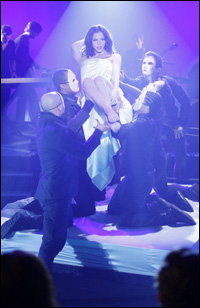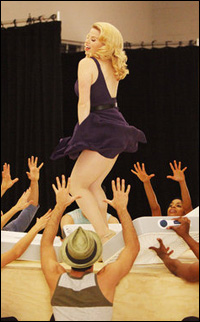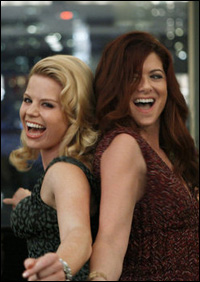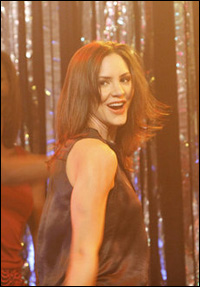
*
Well, maybe it's not so sudden. Bergasse, 39, has danced, sung, acted and/or choreographed over the years on tour (West Side Story, Movin' Out), regionally, in concerts and Off-Broadway (Captain Louie). "Smash" consulting producer Michael Mayer (who helps imagine musical sequences in the TV series) saw Bergasse's choreography in a charity event at New York University and recommended him to the producers of the series. Crafting dozens of musical sequences for a TV series is a long way from his mom's dance school — Annette and Company School of Dance, where he first tap-danced at age three — in Farmington Hills, MI, a suburb of Detroit.
Shooting for the 15-episode first season of Smash — which concerns the rivalry of two actresses (played by Katharine McPhee and Megan Hilty) involved in the creation of a Broadway musical about screen icon Marilyn Monroe — ended March 20. On March 22, Bergasse (pronounced "ber-gass") got the good news that NBC has OK'd a second season. We spoke to him in a cool-down period, before it all starts again.
Now that the first season of "Smash" is shot, you get to relax a little bit?
Joshua Bergasse: Yeah, I do, actually! It felt really weird at first for a couple days, but now I feel the load that's off my shoulders, which is kind of nice.
| |
 |
|
| Katharine McPhee on "Smash." | ||
| photo by Craig Blankenhorn/NBC |
JB: Yeah, it was pretty constant. We started pre-production in August, and shooting at the end of August. It slowly just built up. By the time we got into October, it was nonstop, all-day, every day.
I assume you were simultaneously overseeing dances that were being shot and creating work for future episodes.
JB: Exactly. Yeah. We were prepping one or even two episodes at the same time that we were shooting something.
Can you give me a sense of how far in advance you knew about planned musical numbers?
JB: You know, sometimes it was pretty far in advance. They would plan it out, they would write it, and then we would shoot it later — maybe a month, maybe six weeks later. Then, sometimes, things would happen immediately. We would get an idea, and then we'd have to shoot it in two days; so we would have to cast it, choreograph it and then shoot it — all in two days. You normally have to shoot episode-by-episode. We would have between eight and ten days per episode to shoot, so you're prepping for the week or so before that, and then once you finish that, you're onto the next episode.
What's the process of creating a number in a room with creator Theresa Rebeck, songwriters Marc Shaiman and Scott Wittman and Michael Mayer? Can you talk about the song "20th Century Fox Mambo," for example?
JB: They have an idea of what they want to accomplish in the episode — and then they have the idea for the [musical] number and people [involved]. Marc and Scott write the song. This is how it would work, ideally. For "Mambo," Marc and Scott wrote that song pretty early on because that was in our second episode before things got really crazy. And then, they came to me with the song, and they said they had this idea of [cast members] moving furniture, and she's being transformed from Norma Jean to Marilyn.
Then, I would get into the studio…with a skeleton crew of dancers and start coming up with this stuff. And then I would add more dancers into it, and we'd put it on video, and we'd start sending it around to Theresa and Steven Spielberg and all the executive producers, and they would kind of give notes, and then we'd go back in and re-work it some more. It can be quite a process, especially when you have a lot of time, and there are a lot of people involved. Sometimes with the quicker ones, there's no time for a lot of people to be involved. By the time they get involved we're already shooting it.
| |
 |
|
| Megan Hilty on "Smash." | ||
| photo by Will Hart/NBC |
JB: We have a core of ten dance ensemble for Marilyn the Musical, when we did the "workshop" [episodes]. My boss makes fun of me because I always push for more dancers, and he knows that when I come into his office, it's for me to ask for a bigger number — sometimes the numbers, like "Let's Be Bad," call for a huge ensemble. We augment the ten with another eight. And sometimes the numbers call for less people. It really depends on what the writers come up with, and then I try to throw in extra after that. [Laughs.] But I would say that we have our core ten. My skeleton crew [when creating the musical staging] is usually about half of what the number is going to be. Say there's 15 people in the musical number, my skeleton crew will usually be about seven. [On screen], we have our core ten, and we add people.
You're right: I do have the best dancers in New York, and it's awesome. The problem is: It can't look like there are only ten dancers in New York — that they do every number and every show and are everywhere! I have those ten, but my Marilyn ten can't be in [the chorus of Heaven On Earth, another fictional show in the series] so that has to be a different group of people. And those people can't be doing the Off-Broadway show [seen in the series]. That has to be a different group of people. And, those people wouldn't be cater-waitering, so that has to be a different group of dancers. The good thing about that is that I get to work with tons of different people. Literally, dozens and dozens. I would say maybe we had 100 dancers on this season.
| |
 |
|
| Megan Hilty and Debra Messing | ||
| photo by Patrick Harbron/NBC |
JB: That's correct. My assignment is — especially for the Marilyn the Musical stuff — that it needs to play for a proscenium stage. So I choreograph a number that we can put on stage, and then they shoot it from wide angles, close angles, Steadicam, and I'm involved in helping them find which shots I think are great. And then, it goes to the editors, and the editors kind of pick what they like, with the director. I like to get into the editing room and put my two cents in. And then, it goes to the network, and they have their ideas. But, yes. I do a stage version of the number. With shooting it and editing it, it has a whole new dimension. A lot of people ask me, "Do you think that [editing] takes away from the number?" I don't think so because our editors and everybody is committed to using wider shots, longer shots — not having it be real "cut-y." As long as we stick to that, it's only adding another dimension. It makes it more rich because you don't have to experience it from one angle in the house — from your seat. You can experience it from so many different seats of the theatre.
I think some of the most exciting shots in "Smash" are when we see dancers in the rehearsal room: the parts of the whole — foot, ankle, calf.
JB: It's cool, isn't it? Yeah. It tells a whole different story because you don't pay attention to that when you see it live. You're seeing the whole picture.
Do you choreograph differently for Katharine McPhee than you do for Megan Hilty? Megan has said that she is not a dancer and that she was terrified to take the "Smash" job.
JB: You know what?, Megan is amazing. And, I know she likes to say that she's not a dancer, but nobody can tell that when you watch her. The thing about Kat is that she studied dance as a kid, so it was kind of like riding a bike for her. She was pretty scared a bit at first, but now she loves it. As we got toward the end of the season, she couldn't wait to get into the next dance number. Megan, because she didn't take [dance] as a kid, she was scared, but it's really in her blood. It's what she does. She just owns the stage no matter what she's doing. And there's nothing that I can do to stop that. She is a force of nature.
| |
 |
|
| Katharine McPhee | ||
| Photo by Patrick Harbron/NBC |
JB: That's right. For Marilyn. It's telling the story. The series includes disciplined "show numbers" for Marilyn the Musical and pop numbers performed more loosely — at a karaoke bar, in a dance club, at a bar mitzvah. Plus dream/hallucination numbers. Are you allowed to be more casual with movement in the non-Marilyn numbers?
JB: When we do these fantasies, I think you're a little more free. The situation doesn't necessarily always have to make sense when it's in somebody's head — when it's not really happening, I guess.
Did you have a voice in the writing process? Did Theresa Rebeck seek your advice and say, "What do you want dance-wise?" Or do Marc and Scott create the ultimate template?
JB: We all have a great collaborative energy, and anyone of us can go to the other and say, "Hey, I have an idea…" or, "What if we try something like this?" I'm very grateful that they all value my input as much as they do. I'm able to have conversations with Theresa or with Marc and Scott, and we go in and — sometimes with the director of the episode — we'll sit down and have lunch together on lunch break in between shoots and come up with a new idea for a number, and, by the time lunch is over, somebody pulled the trigger on it and there we go! It makes it such a wonderful process.
I love that the Marilyn songs are not all up-tempo brass week after week. I mean, no one does a Big Show Tune like Shaiman and Wittman, but there is variety in the show's original score — I'm thinking of the simpler ballads, softer energy, like "Mr. and Mrs. Smith."
JB: We want to knock their socks off every week, but it can't be with the same number. They all have to be different. It's just like when you go to a Broadway show: If every number is the same — even if they're fantastic — you're going to get bored. I think that having "National Pastime" one week and then "Mr. and Mrs. Smith" the next week is a great contrast. It also lets people in about what Broadway is really about. It's not going to be all big giant production numbers every time. You're going to have ballads — sweet, simple ballads [like "Mr. and Mrs. Smith"] that mean just as much — and are as meticulously choreographed and staged and shot as big production numbers.
View a clip from "Smash" showing the Bergasse-choreographed musical number "Let's Be Bad":
When you shot the pilot last spring, did you know that you would appear in the series as assistant choreographer "Josh"?
JB: No, I didn't. It was kind of a last-minute thing. I think Theresa called me one day and just asked if I wanted to play the assistant, and I said, "Sure." The assistant wasn't in the script prior to that. I don't know this for sure, but I think it may have been born from when they would come in and watch rehearsals — they would watch my dance rehearsals and what was happening in the room and what the energy was. I think that that's what they're trying to capture for the show — the real thing. I'm so excited about being in the show. [Laughs.] It's so fun, and it's really cool for me.
Well, it's important to show the bones and the structure and process of what the finished product will be.
JB: Right.
Is there more "Josh" to be seen? Is there a story? Do we learn anything about your past with director-choreographer Derek?
JB: No. There's no story. I'm just a very utilitarian character that counts really well and really loud. [Laughs.]
You demonstrate steps, as well.
JB: Yes, that's right.
But nobody does "a 5, 6, 7, 8" like you!
JB: [Laughs.] Thanks! I'm pretty proud of it, I have to say. At one point, when we were shooting, I yelled "5, 6, 7, 8" so loud that the cameraman thought I yelled, "Cut!" [Laughs.] Everything stopped. They stopped the shot. Everybody got a big laugh out of that.
(Kenneth Jones is managing editor of Playbill.com. He pens the weekly "Smash" Report, an episode-by-episode insider's guide to the series. Follow him on Twitter @PlaybillKenneth.)
Playbill Goes On Set with NBC's Broadway-Themed "Smash"









